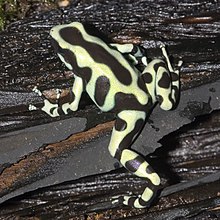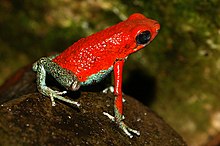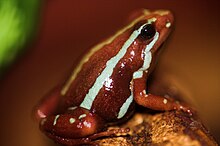Poison dart frogs
| Poison dart frogs | ||||||||||||
|---|---|---|---|---|---|---|---|---|---|---|---|---|

Dyer's frog ( Dendrobates tinctorius ) in bromeliad |
||||||||||||
| Systematics | ||||||||||||
|
||||||||||||
| Scientific name | ||||||||||||
| Dendrobatidae | ||||||||||||
| Cope , 1865 |
The poison dart frogs (Dendrobatidae), also known as poison dart frogs or color frogs , are a family of the frogs (Anura). The often very small (around 12 to 50 mm) and brightly colored frogs are currently divided into a dozen genera and around 170 species. With the dye frog , Dendrobates tinctorius (Cuvier, 1797), a species was first described by a European in the 18th century. The German-language term "poison dart frogs" for the whole family is misleading, since essentially only three species of the genus Phyllobates are used by indigenous peoples for poison darts . Not all substances excreted by poison dart frogs through their skin glands are deadly neurotoxins.
Occurrence
The poison dart frogs inhabit the Central and South American rainforest ; some species can also be found in the highlands of Ecuador . Most species are found east of the Andes in the Amazon basin and the Mata Atlântica . The northern limit of distribution is Nicaragua . There is also an allochthonous population of Dendrobates auratus in Hawaii . These frogs were released there at the beginning of the 20th century.
The animals live at daytime temperatures of 25 to 28 ° C and night temperatures of 22 to 25 ° C and a relative humidity of 70 to 100%. Depending on the species, they inhabit all zones of the neotropical rainforest, from the foliage layer of the ground to the treetop.
features
No webbed feet are formed between the first and second or between the second and third toes. Palatine bones are missing. The same feature states can be found in Allobates , a genus of the Aromobatidae . On the basis of extensive analyzes of microbiological and phenotypic data, it can be assumed that these are convergences .
Reproduction
In the case of smaller species, spawning takes place mainly on the leaves of plants and trees. Larger species ( Dendrobates tinctorius and D. auratus ) are also cave spawners. Depending on the species, a clutch comprises between two and 35 eggs. Spawning is preceded by a courtship ritual that sometimes lasts for hours. The female approaches the male, who is lured by his calls, and strokes his back with her front legs. Both then look for a suitable place to spawn. The spawning is released on bromeliad leaves , for example, via their axils or in the axilla itself. The male inseminates the eggs immediately after they are released. The clutch is mostly guarded by the male. Some species regularly water their clutches by emptying the contents of their bladder onto the eggs.
Poison dart frogs are diurnal; because their bright colors offer them protection during the day. So that their tadpoles are not at the mercy of predators in rivers and ponds, the tadpoles that hatch after 10 to 16 days of embryonic development are transferred to the back of the male in the smallest accumulations of water on plants ( phytotelmata ), such as leaf axils filled with water. With some species (for example Ranitomeya imitator ) this transport takes place individually, with others, for example the three-striped tree climber ( Epipedobates tricolor ), it can encompass the entire clutch at the same time. Later they bring their offspring to the ground in the same way. The females of some species feed the tadpoles with unfertilized eggs until metamorphosis (cf. Oophaga ), while in others the larvae feed on algae or insects that fall into the leaf axils. The development from the tadpole to the young frog takes between six and 14 weeks.
toxicity



Poison dart frogs secrete basic alkaloids through their skin , of which around 200 variants are known ( e.g. pumiliotoxin in Dendrobates , batrachotoxin in Phyllobates ). Batrachotoxin acts on the nervous system. It prevents the inactivation of the sodium channels and is therefore a so-called convulsive toxin. Muscle paralysis and thus also respiratory paralysis occur, which in severe cases can lead to death in humans after about 20 minutes. The poison enters the bloodstream through small injuries or skin pores. An antidote is tetrodotoxin . The poison dart frogs, which release batrachotoxin through their skin, are among the most poisonous animals in the world , along with some box jellyfish and the crust anemone . According to LD-50 , a poison amount of 2 µg / kg is fatal for the victim.
The frogs ingest their venom by eating poisonous prey and sequester it in their bodies. In the last 30 years up to 232 different alkaloids from up to 21 different structural classes have been identified. The highly toxic pumiliotoxins and allopumiliotoxins are acquired through the consumption of mites, whereas other substances enter the frog's body through the ingestion of ants and beetles. The toxins can either be changed ( metabolized ) or remain unchanged by the frog organism . The toxicity of animals kept in captivity decreases over time if no suitable food animals are available. Offspring born in captivity in most cases no longer have any skin toxins .
Poison dart frogs owe their German name to the fact that the skin secretion of three species of the Blattsteiger genus ( Phyllobates terribilis , Phyllobates bicolor and Phyllobates aurotaenia ) is used by certain Indian tribes in western Colombia as a poison arrow when hunting with a blowgun . The secretion is applied to the tips of the arrows . It contains high concentrations of batrachotoxin .
Signal colors and mimicry
With their eye-catching body coloration, poison dart frogs indicate that they are inedible. In biology this mechanism is called aposematism . However, predators usually have to learn this inedibility first. Usually a single experience is sufficient for a predator to develop a lifelong aversion and thus avoidance of this species. Even if the first frog of this species, with which the young animal of a predator becomes acquainted, is often injured or even eaten, all other individuals of this population are spared from this hunter from now on.
Only around a third of the species in the poison dart family produce skin toxins. Some species, which cannot secrete alkaloids, resemble the inedible species in terms of their coloration and drawing and through this adaptation deceive possible predators ( Batessche mimicry ). But poisonous species also adapt to each other in terms of color ( Müllerian mimicry ). One of the first examples that was researched within the amphibian is the species Ranitomeya imitator , which in different parts of its distribution area has the colors and drawings of the poison dart frogs Ranitomeya variabilis (formerly called Dendrobates variabilis ), Ranitomeya summersi (formerly Dendrobates fantasticus ) and mimics Ranitomeya ventrimaculatus (formerly Dendrobates ventrimaculatus ). It has been shown that these color variants actually belong to the species Ranitomeya imitator , although they outwardly resemble the species in certain parts of their range more closely than the other populations of their own species. The mechanisms of variability within the same species and the evolution of the signal colors are the subject of more recent Research work on the tree climber frogs. The co- evolution of frogs and their predators, but also competition within the same species and the selection of males by females come into question.
For a long time, all conspicuously colored poison dart frogs were regarded as closely related and grouped together in the genera Dendrobates and Phyllobates . Likewise, non-toxic species of this family with camouflage colors were placed in the genus Colostethus , which soon comprised over 100 species. It turned out, however, that the possibility of producing skin toxins and aposematic colorations through convergent development within the family emerged several times and are not always due to close relationships. Based on molecular genetic studies, the relationships within the tree-climber frogs have been redrafted over the past two decades.
Species protection
The genera Dendrobates , Epipedobates , Phyllobates and Minyobates are listed on Appendix II of the Washington Convention on Species Protection (CITES). The trade in these animals is strictly regulated. In addition to the wild-caught frogs for the zoo trade in North America and Europe, the increasing deforestation of the rainforest in the poison dart frog habitats represents the greatest threat. Often a population has already become extinct before its species status can be clarified.
The chytrid fungus ( Batrachochytrium dendrobatidis ) is a potty fungus that affects the skin of amphibians and causes them to develop chytridiomycosis , a disease that can be fatal to infested frogs, especially in the cooler regions of the Andes. Many species of poison dart frogs (Dendrobatidae) are therefore more endangered by this fungal disease, which originally came from Africa. The species name of the fungus B. dendrobatidis also refers to this
Systematics and taxonomy
The systematics of the poison dart frog has been fundamentally revised in recent years. Various taxa , which were previously also listed under the Dendrobatidae, were assigned to a newly established family Aromobatidae . The families Aromobatidae and Dendrobatidae arranged in this way are sister groups . The former grouping of the poison dart frogs, which included the Aromobatidae, is thus monophyletic . It was raised to the rank of a superfamily called Dendrobatoidea during the taxonomic conversion . However, the German name Baumsteigerfrösche was adapted to the family level in such a way that it no longer includes the Aromobatidae.
| Dendrobatoidea |
|
||||||||||||||||||||||||||||||||||||||||||||||||||||||||||||||||||
|
|
- Phlylogistic relationships and classification of the poison dart frog
The poison dart frogs were currently divided into three subfamilies, one of which was newly established during the revision.
While the Colostethinae emerge from a basal branch of the poison dart frog, there is a sister group relationship between the Hyloxalinae and the Dendrobatinae. Numerous taxonomic changes have also been made at the level of the genera. Two genres were newly established. In addition, due to phylogenetic studies, many additional species were separated from "collective species" ( species complex ) with a large distribution area and various color morphs . The following classification with three subfamilies and eleven genera is currently emerging.


As of April 4, 2019
Subfamily Colostethinae Cope, 1867 (5 genera, 68 species)
- Genus Ameerega Bauer, 1986
- Genus Colostethus Cope, 1866
- Genus Epipedobates Myers, 1987
- Type three-striped tree climber ( E. tricolor )
- Genus Leucostethus Grant, Rada, Anganoy-Criollo, Batista, Dias, Jeckel, Machado & Rueda-Almonacid, 2017
- Genus Silverstoneia Grant, Frost, Caldwell, Gagliardo, Haddad, Kok, Means, Noonan, Schargel & Wheeler, 2006
Subfamily Dendrobatinae Cope, 1865 (8 genera, 61 species)
- Genus Adelphobates Grant, Frost, Caldwell, Gagliardo, Haddad, Kok, Means, Noonan, Schargel & Wheeler, 2006
- Genus Andinobates Brown et al., 2011
- Genus Dendrobates Wagler, 1830 - Baumsteiger
- Genus Excidobates Twomey & Brown, 2008
- Genus Minyobates Myers, 1987
- Species Minyobates steyermarki (Myers, 1987) is the only remaining species in this genus.
- Genus Oophaga Bauer, 1994
- Genus Phyllobates Duméril & Bibron, 1841 - Blattsteiger
- Genus Ranitomeya Bauer, 1988
- Species belly spot poison dart ( Ranitomeya ventrimaculata )
- Species Ranitomeya amazonica
- Species Ranitomeya benedicta
Subfamily Hyloxalinae Grant, Frost, Caldwell, Gagliardo, Haddad, Kok, Means, Noonan, Schargel & Wheeler, 2006 (3 genera, 70 species)
- Genus Ectopoglossus Grant, Rada, Anganoy-Criollo, Batista, Dias, Jeckel, Machado & Rueda-Almonacid, 2017
- Genus Hyloxalus Jiménez de la Espada, 1871
- Genus Paruwrobates Bauer, 1994
"Colostethus" poecilonotus Rivero, 1991, whose position within the family is unclear, is also added to the Dendrobatidae incertae sedis . "Colostethus" poecilonotus was more precisely classified as Dendrobatoidea incertae sedis, so it could also be a representative of the Aromobatidae.
Individual evidence
- ↑ a b c d e f T. D. Grant, DR Frost, JP Caldwell, R. Gagliardo, CFB Haddad, PJR Kok, BD Means, BP Noonan, W. Schargel & WC Wheeler: Phylogenetic systematics of dart-poison frogs and their relatives ( Amphibia: Athesphatanura: Dendrobatidae). Bulletin of the American Museum of Natural History, 299, 262 pp., 2006 PDF, online
- ↑ Poison Dart Frogs in Hawaii . Explore Biodiversity website. 2007. Retrieved November 19, 2011.
- ↑ Blauer- oder Azure Baumsteiger , Schauige Schönheiten, accessed on December 6, 2017
- ↑ Source: HR: Which poison dart frogs are not poisonous? Journal: Osnabrück Knowledge No. 10 Issue II / 2015.
- ^ RA Saporito, MA Donelly, P. Jain, HM Garraffo, TF Spande & JW Daly: Spatial and temporal patterns of alkaloid variation in the poison frog Oophaga pumilio in Costa Rica and Panama over 30 years . Toxicon , 50, pp. 757-778, 2007
- ↑ Rebecca Symula, Rainer Schulte & Kyle Summers: Molecular phylogenetic evidence for a mimetic radiation in Peruvian poison frogs supports a Müllerian mimicry hypothesis. Proceedings of the Royal Society of London B, 268, pp. 2415-2421, 2001
- ↑ Müllerian mimicry in Dendrobates frogs near Tarapoto, Peru Sample images of Müllerian mimicry in various tree climber frogs (Mimicry & Warning Color, on the UCL website, London)
- ↑ Brice P. Noonan and Aaron A. Comeault: The role of predator selection on polymorphic aposematic poison frogs. Biology Letters, 5, 1, pp. 51–54, 2009 doi : 10.1098 / rsbl.2008.0586 PMC 2657764 (free full text) (English)
- ↑ Miguel Vences, Joachim Kosuch, Renaud Boistel, Célio FB Haddad, Enrique La Marca, Stefan Lötters, Michael Veith: Convergent evolution of aposematic coloration in Neotropical poison frogs: a molecular phylogenetic perspective. Organisms, diversity and evolution, 3, pp. 215-226, 2003
- ↑ CITES . www.cites.org. Retrieved November 19, 2011.
- ↑ Jason Lee Brown, Evan Twomey, Mark Pepper and Manuel Sanchez Rodriguez: A revision of the Ranitomeya fantastica species complex and two new species of poison frogs (Anura: Dendrobatidae) from the Rio Huallaga drainage in central Peru. Zootaxa, 1832, pp. 1-24, 2008
- ^ A b Jason L. Brown, Evan Twomey, Adolfo Amézquita, Moisés Barbosa de Souza, Janalee P. Caldwell, Stefan Lötters, Rudolf von May, Paulo Roberto Melo-Sampaio, Daniel Mejía-Vargas, Pedro Perez-Peña, Mark Pepper, Erik H. Poelman, Manuel Sanchez-Rodriguez & Kyle Summers: A taxonomic revision of the Neotropical poison frog genus Ranitomeya (Amphibia: Dendrobatidae). Zootaxa, 3083, pp. 1-120, 2011
literature
- Taran D. Grant, Darrel R. Frost, JP Caldwell, R. Gagliardo, Célio FB Haddad, PJR Kok, BD Means, Brice P. Noonan, W. Schargel & WC Wheeler: Phylogenetic systematics of dart-poison frogs and their relatives ( Anura: Athesphatanura: Dendrobatidae). Bulletin of the American Museum of Natural History, 299, pp. 1-262, 2006
- RA Saporito, MA Donelly, P. Jain, HM Garraffo, TF Spande & JW Daly: Spatial and temporal patterns of alkaloid variation in the poison frog Oophaga pumilio in Costa Rica and Panama over 30 years . Toxicon, 50, pp. 757-778, 2007
- Wolfgang Schmidt, Friedrich-Wilhelm Henkel: poison dart frogs . 2nd edition, Edition Chimaira, Frankfurt am Main 2008, ISBN 978-3-9306-1291-8
Web links
- List of species of the family Dendrobatidae at Amphibiaweb, Information on amphibian biology and conservation. University of California, Berkeley, USA. Retrieved March 15, 2017
- Darrel R. Frost: Dendrobatidae Cope, 1865 . In: Amphibian Species of the World: an Online Reference . Version 6.0. American Museum of Natural History, New York 1998–2016. Retrieved February 15, 2017
- www.dendrobase.de. Database for species of the superfamily Dendrobatoidea (German, login required)
- www.dendrobates.org (English)
- www.dendrowiki.org. Picture gallery (english)


